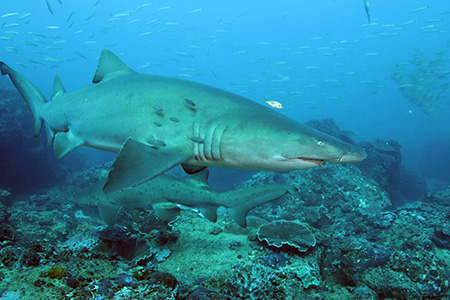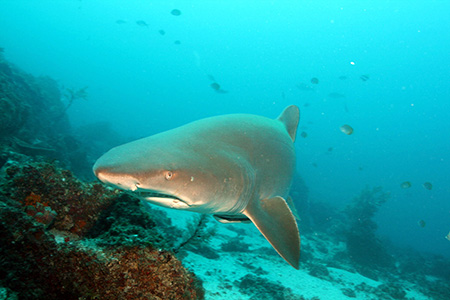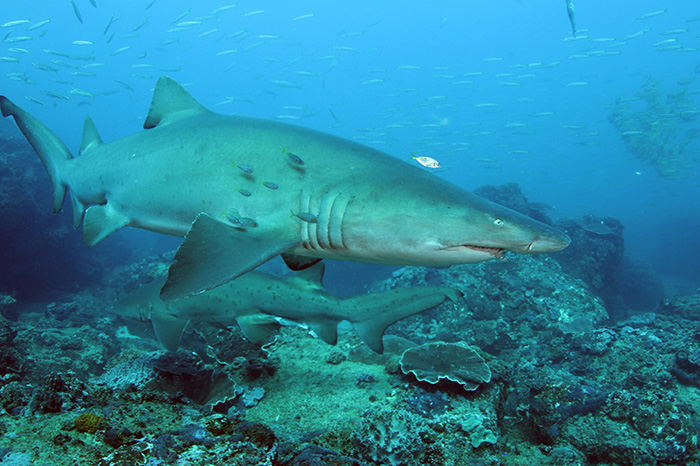Grey nurse shark
Striving for the grey nurse shark’s recovery in Queensland
The grey nurse shark is a docile species, faced with threats from fishing and slow breeding rates, needs support for a sustainable future.

Species overview
The grey nurse shark is often dubbed the Labrador of the sea and is not considered a threat to people.
The grey nurse shark has cultural, spiritual, and ecological significance for many First Nations peoples. This significance varies among different communities.
Also known as the spotted ragged-tooth or sand tiger shark, this distinctive fish lives in the shallow coastal waters from the surf zone down to 200m. In South East Queensland, there are 4 aggregation (hang-out) sites and 1 known gestation site at Wolf Rock in the Great Sandy Marine Park. Marine park zones and grey nurse shark designated areas now protect these sites.
The Australian east coast grey nurse shark population is a genetically isolated population, estimated to be no more than 2,000 individuals, with a breeding population (males and females) thought to be about 400 sharks.
Historically, commercial and recreational fishers targeted grey nurse sharks for their fins, liver oil and jaws. They are also frequently caught as bycatch in commercial fisheries, by recreational fishers and in shark control programs. Combined with their slow breeding rate, this puts their long-term survival at risk.
Ecology and behaviour
An apex predator, the grey nurse shark plays a role in maintaining the health and balance of marine ecosystems by feeding on fish, squid and octopus, smaller sharks, rays and crustaceans. By preying on weak, sick, or injured individuals, the sharks contribute to the overall health of fish populations, encouraging the survival of the fittest.
Sharks have the same five senses as humans and a sixth one—electroreception. The underside of the grey nurse shark's snout is dotted with pores, each leading to an organ (the ampullae of Lorenzini) that can detect electricity. They can use all six senses to detect and attack prey at close range.
Scientists think some sharks use electroreception to navigate using the earth's magnetic field. The shark acts as an electrical conductor moving through the earth’s magnetic field and generating an electrical field. While not yet proven, scientists also believe some sharks may move or migrate at times by responding to changes in this field.
The grey nurse shark has two buoyancy adaptations that enable it to hover almost motionless above the sea floor:
- a large, oily liver – shark oil is lighter than seawater, making the shark more buoyant
- the grey nurse shark also swallows air at the surface and holds it in its stomach.
Grey nurse sharks are ovoviviparous. After the eggs are fertilised, the young develop in egg cases within each uterus in the female. They have no placental connection and hatch inside the female at about 55mm long. The young eat the unfertilised eggs and their siblings. After 9–12 months, 2 young are born, 1 from each uterus.

Characteristics
Grey nurse sharks:
- grow to a maximum length of 3.2m
- mature at 1.9–2.2m (6-7 years for males) and 2.2–2.6m (9–10 years for females)
- only breed every 2–3 years (females)
- are counter-shaded, with a dark grey to bronzy colour upper and a pale lower
- have rows of fang-like, sharp teeth
- have a heterocercal (a tail with a long upper lobe and a shorter lower lobe) with a characteristic subterminal notch
- have an oily liver occupying a large proportion of its body cavity.
Threats
- Commercial and recreational fishing
- Shark control equipment
- Marine pollution.
What’s being done?
Since 2001, and in support of the National Recovery Plan for the species, we have been involved in monitoring and conservation initiatives including:
- conducting surveys and acoustic telemetry (using acoustic tags and receivers) to identify whether locations where grey nurse sharks have been recorded are aggregation sites, including in the Great Barrier Reef Marine Park (since 2024).
- conducting acoustic telemetry at Wolf Rock (since 2015) and Flat Rock, Henderson Rock and Cherubs Cave (since 2017) to understand how the sharks use these areas.
- supporting the development of a citizen science program for the grey nurse shark.
- developing a regional management strategy for the Great Sandy Marine Park.
- supporting Sea World to rescue, rehabilitate, tag and release injured sharks.
- coordinating research to investigate the impacts of scuba divers on grey nurse sharks at Wolf Rock and Flat Rock.
- collaborating with Sea World, Australia Zoo, The University of Queensland, The University of the Sunshine Coast, and the IMOS Qld Acoustic Array to:
- use satellite and acoustic telemetry to find other aggregation sites in Queensland, particularly gestation sites
- increase the number of grey nurse sharks with internal long-life acoustic tags for ongoing monitoring.
- sharing research and monitoring data to inform planning and reviews of marine parks and protected areas, including grey nurse shark designated areas and overlapping marine national parks zones. In marine national park zones and designated grey nurse shark areas, fishing is prohibited, and diving and other human activities are restricted.
- sharing our research and monitoring data to inform recovery actions, including minimising, where possible, the impacts of fishing and the shark control program on the grey nurse shark.
Who is helping?
- The University of the Sunshine Coast (USC)
USC researchers survey grey nurse shark populations at Wolf Rock and Flat Rock.
Another USC research team investigates the perspectives of grey nurse shark tourism operators in Southeast Queensland.
USC researchers also partner with us to help analyse and publish peer-reviewed papers using acoustic and satellite telemetry data. - Sea World
Sea World staff rescue and care for stranded, injured and sick grey nurse sharks. They partner with us on the grey nurse tagging program. - Biopixel Oceans Foundation
Foundation staff assist with capturing grey nurse sharks for acoustic and satellite telemetry. - Australian Institute of Marine Science (AIMS)
AIMS leads the Integrated Marine Observing System (IMOS) Queensland acoustic telemetry array, dedicated to observing and monitoring the marine environment. - Great Barrier Reef Marine Park Authority (GBRMPA)
GBRMPA partners with us to investigate the use of the Great Barrier Reef by grey nurse sharks and is a member of our grey nurse shark research, monitoring and conservation management working group (Grey Nurse Shark Recovery Group). - Commonwealth Department of Climate Change, Energy, the Environment and Water
The department is a member of our Grey Nurse Shark recovery group. - Queensland Department of Agriculture and Fisheries (DAF)
DAF is a member of our Grey Nurse Shark Recovery Group. - Grey Nurse Shark Watch
This Queensland-based citizen science project collects data and photos of grey nurse sharks from recreational divers for research and monitoring projects. - Dive and tourism operators
Responsible operators working in grey nurse shark areas assist with shark monitoring, research and rescues. - NSW Department of Primary Industries
We have a data-sharing agreement with this department to inform monitoring and conservation activities for the east coast.
How you can help
- Report sick and injured grey nurse sharks immediately by calling 1300 130 372.
- Respect grey nurse shark designated areas and do not:
- touch or feed a grey nurse shark
- dive between 6pm and 6am
- chase, harass or interrupt swimming patterns or interfere with a shark's natural behaviour
- attempt to block cave entrances or gutters or entrap grey nurse sharks
- use mechanical or electro-acoustic apparatus including, but not limited to, scooters, horns and shark-repelling devices
- dive in a group of more than 10 people.
- If you accidentally catch a grey nurse shark while fishing:
- remain calm and ensure your safety
- keep the shark in the water, if possible, to avoid causing it undue stress
- use a dehooking device to remove the hook safely, or if this is impossible, cut the line as close to the hook as possible
- release the shark promptly and gently
- if the shark is entangled and can’t be released call the 24/7 Shark Control Program Hotline on 1800 806 891.
- If you are a recreational diver, share your shark photos and encounters with Grey Nurse Shark Watch program.

